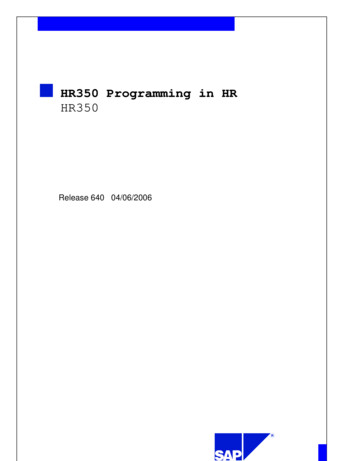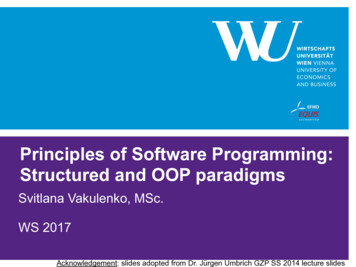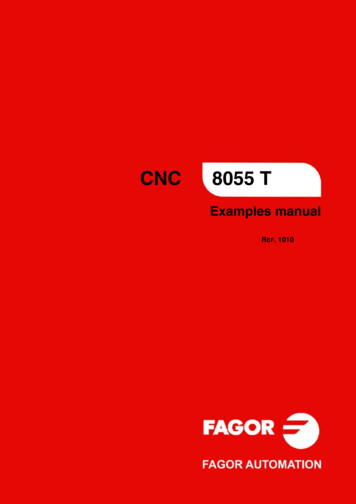
Transcription
HR350 Programming in HRHR350Release 640 04/06/2006
HR350 Programming in HRHR350Programming in HRTHE BEST-RUN BUSINESSES RUN SAPSAP AG 2003 SAP AG 2003SAP R/3 Enterprise2003/Q350063940
CopyrightCopyright 2004 SAP AG. All rights reserved.No part of this publication may be reproduced or transmitted inany form or for any purpose without the express permission ofSAP AG. The information contained herein may be changedwithout prior notice. SAP AG 2004Some software products marketed by SAP AG and its distributors contain proprietary software components ofother software vendors.Microsoft, Windows, Outlook, and PowerPoint are registered trademarks of Microsoft Corporation.IBM, DB2, DB2 Universal Database, OS/2, Parallel Sysplex, MVS/ESA, AIX, S/390, AS/400, OS/390, OS/400,iSeries, pSeries, xSeries, zSeries, z/OS, AFP, Intelligent Miner, WebSphere, Netfinity, Tivoli, and Informix aretrademarks or registered trademarks of IBM Corporation in the United States and/or other countries.Oracle is a registered trademark of Oracle Corporation.UNIX, X/Open, OSF/1, and Motif are registered trademarks of the Open Group.Citrix, ICA, Program Neighborhood, MetaFrame, WinFrame, VideoFrame, and MultiWin are trademarks orregistered trademarks of Citrix Systems, Inc.HTML, XML, XHTML and W3C are trademarks or registered trademarks of W3C , World Wide WebConsortium, Massachusetts Institute of Technology.Java is a registered trademark of Sun Microsystems, Inc.JavaScript is a registered trademark of Sun Microsystems, Inc., used under license for technology invented andimplemented by Netscape.MaxDB is a trademark of MySQL AB, Sweden.SAP, R/3, mySAP, mySAP.com, xApps, xApp, and other SAP products and services mentioned herein as well astheir respective logos are trademarks or registered trademarks of SAP AG in Germany and in several othercountries all over the world. All other product and service names mentioned are the trademarks of their respectivecompanies. Data contained in this document serves informational purposes only. National product specificationsmay vary.These materials are subject to change without notice. These materials are provided by SAP AG and its affiliatedcompanies ("SAP Group") for informational purposes only, without representation or warranty of any kind, andSAP Group shall not be liable for errors or omissions with respect to the materials. The only warranties for SAP
Group products and services are those that are set forth in the express warranty statements accompanying suchproducts and services, if any. Nothing herein should be construed as constituting an additional warranty.
Course PrerequisitesRequirements:HR100 (Essentials of Personnel Administration)HR120 (Essentials of Personnel Planning)BC400 (ABAP Workbench: Foundation)BC405 (Techniques of List Processing)Experience of programming in ABAP SAP AG 2003
Target GroupTarget group:IT staffIT administratorsDuration:5 days SAP AG 2003Note:The training materials do not constitute a teach-yourself program. They complement the courseinstructor's explanations. Your material includes space for making note of additional information.There may not be enough time to complete all exercises during the course. The exercises containadditional examples that are dealt with during the course. Participants can use these examples toconsolidate their knowledge once they have completed the course.
Course OverviewContents:Course GoalsCourse ObjectivesCourse ContentMain Business Scenario SAP AG 1999(C) SAP AGHR3501-1
Course GoalsThis course will prepare you to:Program your own HR reports using logical databasesand HR-specific statementsCreate customer-specific infotypes SAP AG 2003(C) SAP AGHR3501-2
Course ObjectivesAt the conclusion of this course, you will be able to:Use the HR logical databases and the Join andProjection viewsUse HR-specific statementsImport and process payroll resultsCreate customer-specific infotypes SAP AG 2003(C) SAP AGHR3501-3
Course ContentPrefaceUnit 1Course OverviewUnit 7Unit 2Data Structures inPersonnelAdministrationCluster DatabaseTables in HRUnit 8Data Structures inPersonnel PlanningUnit 9The Logical DatabasePCHUnit 3The LogicalDatabasesPNP/PNPCEUnit 4Join and ProjectionUnit 5Specific CommandsUnit 6Repetitive Structuresand List DisplayUnit 10 Customer-SpecificInfotypesUnit 11 HR ABAP FeaturesAppendixIntroduction to HR SAP AG 2003Note:In the sample source code contained in these training materials, all ABAP keywords and the namesof HR data structures are printed in upper case.In the solutions for the programming exercises, only the ABAP keywords are written in upper case.One part of the appendix contains additional overheads, which the trainer can incorporate into thecorresponding units, where appropriate.Another part contains material for an introduction to HR, which the trainer may use at the start of thecourse, if necessary.(C) SAP AGHR3501-4
Main Business ScenarioAll components of the HR system have beenimplemented at your company.The Personnel Department in your company requiresits own reports and customer-specific infotypes tocover special requirements. SAP AG 2003(C) SAP AGHR3501-5
Data Structures in Personnel AdministrationContentsInfotypesTechnical data structures of infotypesCheck and control tables SAP AG 2003(C) SAP AGHR3502-1
Data Structures in Personnel Administration:Unit ObjectivesAt the conclusion of this unit, you will be able to:Describe the data structures of PersonnelAdministrationUse the check and control tables of HR infotypesas a source of information SAP AG 2003(C) SAP AGHR3502-2
Data Structures in Personnel Administration:OverviewCourse OverviewCluster Database Tables inHRData Structures inPersonnel AdministrationData Structures inPersonnel PlanningThe Logical DatabasesPNP/PNPCEThe Logical Database PCHJoin and ProjectionCustomer-Specific InfotypesSpecific CommandsHR ABAP FeaturesRepetitive Structures andList Display SAP AG 2003(C) SAP AGHR3502-3
Data Structures in Personnel Administration:You want to draw up your own evaluations of data inPersonnel Administration. To do this, you must learnabout data structures in Personnel Administration. SAP AG 2003(C) SAP AGHR3502-4
Infotypes: Topic ObjectivesAt the conclusion of this topic, you will be able to:Describe the concept of infotypes in HR SAP AG 2003(C) SAP AGHR3502-5
Data Structures in ContextPAnnnnMaster/time dataPCL1PCL2PBnnnnAccounting resultsApplicant dataPersonnel planningHRPnnnnDatabase for work areasPCL3RecruitmentPCL4DocumentsPCL5Personnel cost planning SAP AG 2003Data structures in HR are a combination of master data, transaction data, and results data.The master data of Personnel Administration, Time Management, and Personnel Planning are structuredin the same way.There are also different data clusters, which contain data from specific processing steps, such as timeevents on cluster PCL1 or accounting results on cluster PCL2.The infotypes are grouped into different number ranges nnnn:- 0000 – 0999 HR master data- 1000 – 1999 Personnel Planning- 2000 – 2999 Time Management- 4000 – 4999 Recruitment- 9000 – 9999 Customer-specific enhancements(C) SAP AGHR3502-6
Infotypes in Personnel AdministrationWorking timeFamilyBank detailsBirthcertificateStaff/job applicantsAddress/personal dataOrg. assignment SAP AG 2003Infotypes are information units in the Human Resources Management system. Groups of related datafields are bundled into infotypes.Infotypes structure information, facilitate data entry and allow data to be saved for specific periods.Infotypes serve as templates for users to enter data. From a database point of view, infotypes provide adata structure and a set of coherent data records.The infotypes Actions 0000, Organizational Assignment 0001, Personal Data 0002, and Payroll Status0003 are prerequisites for entering a personnel or applicant number.Save the infotypes at intervals to build up an infotype history. The system stores a validity period foreach infotype record. Therefore, several data records usually exist for each infotype of an employee, andeach record has a different validity period.You use a time constraint to determine how the data records of an infotype react to each other in termsof time.Several infotypes have subtypes, which break down information further. For example, technicallyspeaking, the address types for infotype Address 0006 represent the subtypes.(C) SAP AGHR3502-7
Infotype Time Constraint123Hiring date9999 SAP AG 2003Each infotype and subtype has a time constraint.Time constraint 1: Complete saving with no overlaps at any time, that is, one valid data record of therelevant infotype must exist during the duration of the employee's employment at the company.Time constraint 2: Incomplete saving without overlaps at any time, that is, of an infotype may exist at agiven time. No more than one valid data record of the infotype can exist at any given time.Time constraint 3: Incompleteness and overlaps permitted, that is, any number of valid data records ofan infotype may exist at any given time.(C) SAP AGHR3502-8
Technical Data Structures of Infotypes:Topic ObjectivesAt the conclusion of this topic, you will be able to:Explain the technical data structures of the infotypesin Personnel Administration SAP AG 2003(C) SAP AGHR3502-9
Structure of Transparent TablesThe structure of transparent tables:PA0000PA0001Key infotype PA0001Key infotype PA0002PA0002BUKRSNACHN.ABKRS .VORNA . SAP AG 2003The data records of the infotype nnnn are saved in the transparent database tables PAnnnn.The table's primary key refers to a minimum quantity of fields in a table, whose value uniquelyidentifies each data record of the table. In this context, minimum means that after any field is removedfrom the key, the remaining fields no longer uniquely identify the data records.The fields involved in a primary key are referred to as the table's key fields. This means that a valuecombination of the key fields may only occur once in a table.A transparent table is made up of the primary key and other non-primary keys. As regards infotypetables, non-primary fields include above all the infotype-specific fields, which contain the actual data orinformation on the infotype.(C) SAP AGHR3502-10
Personnel Administration Transparent TablesTransparent tables dictionary field definitionExample: PA0002MANDTPERNRSUBTY.SEQNR.INCLUDE PAKEYAEDTM.PREAS.INCLUDE PSHD1INITSNACHN.INCLUDE CI P0002.INCLUDE PS0002 SAP AG 2003Each PAnnnn infotype table and the client (MANDT field) is defined in the ABAP Dictionary using thefollowing three include structures:PAKEY:Contains the infotype table key fieldsPSHD1:Contains administrative information on the infotype record (amongst other things, the date the lastchange was made and the name of the user who made the change)PSnnnn:Contains the infotype-specific fields that hold the infotype's actual information and data(C) SAP AGHR3502-11
Key FieldsPERNR.INCLUDE PAKEYSUBTYOBJPSSPRPSENDDABEGDASEQNR SAP AG 2003The PAKEY structure contains an infotype's primary key. It is the same for all Personnel Administrationinfotypes and is made up of the following key fields:PERNR: In a client, the personnel number is the only unique key that identifies an employee. It can beused to display and maintain master data and working time data (infotypes) for an employee.SUBTY: Subtypes are subdivisions of infotypes. The subtypes of an infotype may have different timeconstraints and create their own history.OBJPS: The object identification indicator is used to differentiate records with the same infotype,subtype, lock indicator, valid from date, and valid to date. For example: Child number in infotype 0021Family Member/Dependents. SPRPS: The lock indicator for HR master data can be used to lock andunlock data records. It can be used to guarantee double control, that is, at least two users are involved inwriting an active data record to the database. One of the users creates a locked infotype record. Anotheruser unlocks this record by activating it.ENDDA: Valid to dateBEGDA: Valid from dateSEQNR: The sequential number differentiates infotype records with the same key and the timeconstraint '3'. Unlike the personnel object identification, it is automatically assigned by the system.(C) SAP AGHR3502-12
Administration FieldsAEDTM.INCLUDE PSHD1UNAMEHISTOITXEXREFEXORDEXITBLDPREASFLAG1FLAG2 SAP AG 2003The structure PSHD1 is another basic structure that is the same for all Personnel Administrationinfotypes. Other basic administrative information for each infotype is saved here.This information includes the date the record was changed (AEDTM), the name of the person makingthe change (UNAME), and information on whether the administrator created plain text for this infotype(ITXEX).(C) SAP AGHR3502-13
Data Fields in the Structure PSnnnnExample: PA0002INITS.INCLUDE PS0002NACHNNAME2.INCLUDE CI P0002NACH2VORNACNAMETITEL. SAP AG 2003The structure PSnnnn contains the infotype-specific data fields, that is, the data fields that contain theactual infotype-specific characteristics.Each Personnel Administration infotype contains an include CI Pnnnn in the data structure PSnnnn.Customer-specific fields can be added to this include as enhancements to an infotype. In the standardSAP system, the include CI Pnnnn is empty.(C) SAP AGHR3502-14
The Infotype Structure PnnnnDB structure PAnnnn using infotype 0002 as an examplePA0002MANDTPAKEYPSHD1PS0002Infotype structure Pnnnn using infotype 0002 as an examplePSKEYPSHD1PS0002 SAP AG 2003During interface definition, the logical structure Pnnnn is used between programs and betweenprograms and screens.The key PSKEY contains the key fields of the structure PAKEY, and an additional field INFTY for theinfotype number nnnn. The client field is not required in this structure.The structure PSnnnn is also included by the structure Pnnnn so that the transparant table PAnnnn andthe logical structure Pnnnn are always consistent with each other.(C) SAP AGHR3502-15
Additional Structures for Screen FieldsScreen fields for HR master data RP50M.INFTX .SPRTXStructure Q0002.ANREX(5).Infotype structure PS0002.ANRED(1). SAP AG 2003Fields (such as header lines) that are displayed for all infotypes are stored in the structure RP50M.The structure Qnnnn also exists for several infotypes. It contains screen fields for data entry. Anemployee's form of address, for example, is stored with a numeric key in the field PA0002-ANRED. Thescreen, however, must enable the form of address itself to be displayed and entered, not its numeric key.For this reason, the additional field Q0002-ANREX is used.(C) SAP AGHR3502-16
Infotype Views/Additional InfotypesInfotype view consisting of a primary and secondary (additional) infotypePrimary infotype PA0021Key PA0021FAMSAFGBDT.EMRGNSecondary (additional) infotype PA0335Key PA0335FULNAFINUM.DADEATables T582V/T582W: View definition - assignment of additional infotype to primary infotype SAP AG 2003Many country versions require country-specific fields that are attached to all international infotypes,such as Organizational Assignment, Family Member/Dependents.To prevent international infotype structures being crammed with country-specific fields, these fieldshave been moved to additional infotypes.Whereas international infotypes ("primary infotype") have the value I, additional infotypes have thevalue Z in the Infotype/View field in the table T777D.The primary infotype and the additional infotype are maintained together on one screen in an infotypeview (defined using the tables T582V and T582W). Then the infotypes are saved, the data you aremaintaining is distributed across two infotype records (one primary and one additional infotype record)with an identical infotype key.The infotype menu only contains the international primary infotype. The additional infotype can only bemaintained with the primary infotype, and not on its own. All infotype characteristics such as the timeconstraint are only defined on the primary infotype.When a personnel number is being created, the attribute IVWID is used to assign a fixed view indicatorin the infotype Payroll Status 0003. The secondary infotypes are selected using this view indicator.This view indicator must NEVER be changed, for obvious reasons.(C) SAP AGHR3502-17
Overview of PA Data KEYStructure-NoPSHD1Structure-NoPSnnnnStructureCI PnnnnPS0nnn-PS8nnn: OnlyCI PnnnnPS9nnn: YesPnnnnStructurePSKEYPSHD1PSnnnnP0nnn-P8nnn: NoP9nnn: Only A0nnn-PA8nnn: NoPA9nnn: Only PS9nnnCI PnnnnStructure-Yes SAP AG 2003The table displayed above provides an overview of the data structures and transparent tables that belongto an infotype in Personnel Administration.(C) SAP AGHR3502-18
Check and Control Tables: Topic ObjectivesAt the conclusion of this topic, you will be able to:Use the technical information contained in the checkand control tables of HR infotypes SAP AG 2003(C) SAP AGHR3502-19
Check and Control Tables HR InfotypesT777DCheck table for allHR infotypesT77IDEnhancements totable T777DT582AT77CD(Personnel Administration)(Personnel Planning) SAP AG 2003The table Infotypes - Dialog/Database Assignment (T777D) is the key check table (domain INFOTYP)for all HR infotypes (administration and planning infotypes). This table contains the names of allinfotype-dependent repository objects (such as tables, structures, and programs).The table Infotypes - Enhancements to T777D (T77ID) supplements the table T777D that exists forreasons of memory space.The table Infotypes - Customer-Specific Settings (T582A) is used to make customer-specific settings foradministration infotypes.The table Infotypes - Customer-Specific Settings (T77CD) can be used to make customer-specificsettings for planning infotypes.You can use the report RHT777DCHECK to check the consistency of entries in the specified tables.(C) SAP AGHR3502-20
Check Table HR InfotypesInfotype controlTable T777DInfotypeStructureDB 999PA9998HRP9999DB TableTable InfotypeHRT1002 SAP AG 2003The table Infotypes - Dialog/Database Assignment (T777D) is automatically maintained using the toolfor creating new infotypes. Do not edit this table manually.In addition to the transparent tables PAnnnn and HRPnnnn, each infotype in the Human ResourcesManagement system has a logical structure Pnnnn (stored in T777D-PPNNN).Logical structures are used to define interfaces between programs and between screens and programs.No data records exist on the database for a logical structure.To avoid direct database accesses, these logical structures Pnnnn are primarily used in HumanResources Management programs.(C) SAP AGHR3502-21
Infotypes - Enhancements to T777DTable T777DInfotype Structure Infotype-Spec. Fields00000001.10001003.16111612.99989999Prim. Table Ext. InfotypePS0000PS0001HRI1000HRI1003HRI1611HRI1612V T5U27V T5U26PS9998HRI9999 SAP AG 2003The table Infotypes - Enhancements to T777D (T77ID) only supplements the Infotypes Dialog/Database Assignment table T777D, for reasons of memory space.This table includes the structure PSnnnn or HRInnnn for infotype-specific fields for each infotype.(C) SAP AGHR3502-22
Database Tables forApplicant InfotypesControl applicant infotypesTable T777DInfotypeDB Table000000010002 00060007 400040014002PA0000PA0001PA0002DB Table Applicant PB4001PB4002 SAP AG 2003Infotype records for applicant infotypes are stored in the transparent tables PBnnnn, which arestructured in the same way as PAnnnn tables.The following types of applicant infotypes exist:Infotypes that can be maintained for employees and applicants (for example, 0001, 0002, 0006, and0007). Here, there is a database table PAnnnn for employee data and a database table PBnnnn forapplicant data.Infotypes that may only be maintained for applicants (applicant infotypes only, with infotype numbersfrom 4000 to 4999). Here, there is only one database table solely for applicant data (PB4nnn).(C) SAP AGHR3502-23
Subtypes for Personnel Administration InfotypesSubtype controlTable T777DInfotype Subtype Field Subtype Table Subtype Text Tab.0006.0008000900100011.0019.0022TC T591BTMARTT531T531SSLARTT517TT517T SAP AG 2003Subtypes are used to further break down infotypes, for example, to further classify infotype 0006Addresses into main address, second address, business address, and so on.In the table T777D, the following fields are used to define subtypes:Subtype field: Here, the field is in the infotype structure that contains the subtype. Usually this is thefield SUBTY. However, it may also be a field other than SUBTY and contain the value of the subtype(for example, ANSSA address type in the infotype 0006).Subtype table: This contains the check table that contains all allowed subtype values for each infotype.This is usually the table T591A. However, the subtype values may also be stored in another table depending on the subtype field - for example, the table T512Z for infotype 0011 Ext. Bank Transfers(permissible wage types for each infotype), as the wage type (field LGART) is also the subtype.Subtype text table: This lists the text table for the subtype table, that is, the table with the names for theindividual subtype values. This is usually the table T591S, if the table T591A is used as a subtype table.If another subtype table is used (for example, T512Z), the corresponding text table (for example, T512T)is stored here.Time constraint table: If the time constraint is defined based on the subtype, the corresponding timeconstraint table appears here (for example, T591A/T591B).(C) SAP AGHR3502-24
Data Structures in Personnel Administration:SummaryYou are now able to:Describe the data structures of PersonnelAdministrationUse the check and control tables of HR infotypes as asource of information SAP AG 2003(C) SAP AGHR3502-25
Data Structures in Personnel Administration:ExercisesUnit: Data Structures in Personnel AdministrationAt the end of this exercise, you will be able to: Describe the data structures of Personnel Administration Use the check and control tables of HR infotypes as a source ofinformationYou want to draw up your own evaluations of Personnel Administrationdata. To do this, you must learn more about data structures in PersonnelAdministration.1-1The fields SPRPS and OBJPS are located in the key of Personnel Administrationinfotypes. Write down the functions of both fields.1-1-1 SPRPS:1-1-2 OBJPS:1-2What tasks do the structures Qnnnn and CI Pnnnn fulfil?1-2-1 Qnnnn:1-2-2 CI Pnnnn:1-3Several infotypes have subtypes. If this is the case, the infotype’s time constraint is onthe subtype.1-3-1 How do you determine which time constraint is assigned to the subtype of aninfotype?(C) SAP AGHR3502-26
(C) SAP AGHR3502-27
Data Structures in Personnel Administration:SolutionsUnit: Data Structures in Personnel Administration1-1The fields SPRPS and OBJPS are located in the key of Personnel Administrationinfotypes. Write down the functions of both fields.1-1-1 SPRPS:If this field is not blank, the infotype record is locked. It needs to be unlockedto be activated.1-1-2 OBJPS:This field is used to differentiate infotype records with the same infotype,subtype, block indicator, valid from date, and valid to date.1-2What tasks do the structures Qnnnn and CI Pnnnn fulfil?1-2-1 Qnnnn:The structure Qnnnn contains screen fields with different lengths than thecorresponding database fields.1-2-2 CI Pnnnn:The customer-specific fields of a standard infotype are grouped in the structureCI Pnnnn.1-3Several infotypes have subtypes. If this is the case, the infotype’s time constraint is onthe subtype.1-3-1 To establish the time constraint of the infotype’s subtype, determine which timeconstraint table is assigned to the infotype in the table T777D. View the table.(C) SAP AGHR3502-28
The Logical Databases PNP/PNPCEContents:Functions of the logical databaseData retrievalProcessing of infotypesPeriod-based dataPerson selection and data selectionSort orderSetting up the selection screenSelection view for free delimitationsThe logical database PNPCE SAP AG 2003(C) SAP AGHR3503-1
The Logical Databases PNP/PNPCE:Topic ObjectivesAt the conclusion of this unit, you will be able to:Explain the functions and data structures of thelogical database PNPProcess period-based data in a reportUse the screening criteria to select data and personsSet up the standard selection screenCreate a selection view for free delimitationsUse the logical database PNPCE in PNP mode SAP AG 2003(C) SAP AGHR3503-2
The Logical Databases PNP/PNPCE: OverviewCourse OverviewCluster Database Tables inHRData Structures inPersonnel AdministrationData Structures inPersonnel PlanningThe Logical DatabasesPNP/PNPCEThe Logical Database PCHJoin and ProjectionCustomer-Specific InfotypesSpecific CommandsHR ABAP FeaturesRepetitive Structures andList Display SAP AG 2003(C) SAP AGHR3503-3
The Logical Databases PNP/PNPCE: BusinessScenarioThe Personnel Department in your company requiresits own reports to evaluate HR master data.As a member of the IT team, it is your responsibility toprogram these reports.You would like to make optimal use of the functionsoffered by the logical databases in HR. SAP AG 2003(C) SAP AGHR3503-4
Functions of the Logical Database PNP1. Data retrieval2. Screening3. Authorization check SAP AG 2003To minimize the amount of programming required, it often makes sense to use logical databases whengenerating reports. Reports are special programs that provide selection screens and access databases.The logical database PNP consists of the database driver SAPDBPNP and is activated using the reportattributes. It fulfils three main functions:Data retrieval:HR data is written for each employee to the main memory, where it can be processed.Screening: A selection screen enables you to select employees in accordance with organizational criteria.For example, you can select all of the hourly wage earners of a particular personnel subarea.Authorization check: The implicit authorization check is another advantage of the logical database.Personnel data is frequently confidential and it does not make sense to allow all programs carry out theauthorization check.(C) SAP AGHR3503-5
Data Retrieval1. Create data structures for infotypesTABLES: PERNR.INFOTYPES: 0001,0002,0007."Organizational Assignment""Personal Data""Planned Working Time"2. Fill the data structures with the infotype recordsGET PERNR. SAP AG 2003The structure PERNR must be declared with the TABLES statement.The INFOTYPES nnnn statement is used to create an internal table with the name Pnnnn for eachdeclared infotype.When the GET event occurs, the tables of declared infotypes are filled with all of the records that existfor a personnel number. The field PERNR in the structure PERNR contains the personnel number. Forpurposes of processing, you can access the PERNR-PERNR field. This field contains the formattedname of the employee.Note: When the GET event occurs, all internal infotype tables are filled. Therefore, only declare theinfotypes you wish to process. You can, however, use the enhancement MODE N for the statementINFOTYPES to suppress the filling of internal tables.(C) SAP AGHR3503-6
Processing Infotypes (1)TABLES: PERNR.INFOTYPES: 0000,0002,0006,."Actions"Personal Data"AddressesGET PERNR.LOOP AT P0002 WHERE ENDDA GE PN-BEGDAAND BEGDA LE PN-ENDDA.WRITE.ENDLOOP. SAP AG 2003When the GET PERNR event occurs, the infotype records are imported to internal tables Pnnnn (forexample, P0006 for infotype 0006). These tables may then be processed in a LOOP-ENDLOOP loop.All infotype records whose validity period overlaps the period selected in the selection screen (PNBEGDA and PN-ENDDA) by at least one day are placed one after the other in the header of therespective infotype table Pnnnn.For example, if you choose the current year in the selection screen, PN-BEGDA contains the first day ofthe year and PN-ENDDA contains the last day of the year. If you do not enter any data for the period inthe selection screen, PN-BEGDA contains the low date (January 01, 1800) and PN-ENDDA contains thehigh date (December 31, 9999).Note: Infotypes with the time constraint 3 must be processed in this way.(C) SAP AGHR3503-7
Processing Infotypes (2)TABLES: PERNR.INFOTYPES: 0001,0002,0006,."Actions"Personal Data"AddressesGET PERNR.PROVIDE * FROM P0002BETWEEN PN-BEGDA AND PN-ENDDA.WRITE.ENDPROVIDE. SAP AG 2003Infotypes with the time constraint 1 or 2 may be processed with a PROVIDE-ENDPROVIDE loop.All infotype records whose validity period overlaps the period selected in the selection screen (PNBEGDA and PN-ENDDA) by at least one day (BETWEEN-AND) are placed one after the other in theheader of the respective infotype table Pnnnn.Note: If you have entered period dates in the selection screen, the contents of the fields Pnnnn-BEGDAand Pnnnn-ENDDA are also reset in the header of the infotype table Pnnnn. For example, if the date inPnnnn-ENDDA is after the date in PN-ENDDA, Pnnnn-ENDDA is given the value from PN-ENDDA.(C) SAP AGHR3503-8
Processing Infotypes (3)TABLES: PERNR.INFOTYPES: 0000,0002,0006,."Actions"Personal Data"AddressesGET PERNR.PROVIDE * FROM P0006BETWEEN PN-BEGDA AND PN-ENDDAWHERE P0006-SUBTY '1'.WRITE.ENDPROVIDE. SAP AG 2003If the infotype to be maintained has subtypes, it must be processed with the subtype. This is broughtabout by the WHERE condition in the PROVIDE statement. In the above example, processing o
(C) SAP AG HR350 2-8 SAP AG 2003 Infotype Time Constraint 1 2 3 Hiring date 9999 Each infotype and subtype has a time constraint. Time constraint 1: Complete saving with no overlaps at any time, that is, one valid data record of the relevant infotype must exist during the duration of the employee's employment at the company.










